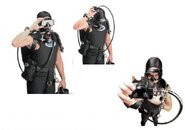Oh, so I am not allowed to add my support or offer a post?! Sorry, but I felt more clarification was necessary
Keep your shirt on... I was agreeing with you and citing your answer as one good example of how the OPs concerns have been addressed
Welcome to ScubaBoard, the world's largest scuba diving community. Registration is not required to read the forums, but we encourage you to join. Joining has its benefits and enables you to participate in the discussions.
Benefits of registering include
Oh, so I am not allowed to add my support or offer a post?! Sorry, but I felt more clarification was necessary
- (Biggest one of all IMO) The donated reg is always where it's meant to be and never dangling unsecured 'somewhere'.
Negatives of long hose (hog or otherwise):
- If the OOD starts to ascend too quickly and he's out of reach, regaining control could get pretty messy.
I can't really get away from that point. If he's actually run out of air it probably means he's not an attentive diver. If that's his nature then there's a fair chance he'll also have poor control over his ascent rate, especially if it's vertical with no reference. Can't see myself ever wanting to let an OOA diver get beyond an arms reach once he's breathing off my reg.
c. IF the person does bolt and gets away from you, how is that different from bolting and getting away from you with a 36" "standard" Octo hose?
The amount of muppetry required to get to that point is pretty high, tbh.
You, of all people, should know that that AAS protocol involves establishing and maintaining contact with the distressed diver ...
So AAS procedures with a long hose requires you never lose contact with an OOD you're donating to?
My final safety 'issue' I have here is feeling pretty weak now though in light of the very valid point made by Boulderjohn about the 'missplaced octopus' situations. I have to concede that in practice the safety offered by always knowing where your donated air source is located far outweighs any potential issue arising from letting the OOD diver get beyond your reach IMO.
I know there's an argument that a long hose gives people room to move etc..., but I route my occy from the left, over the top of my shoulder flush with my chest down the side of my LP hose with the 2nd stage attached to my bcd waistbelt (photo's to follow).
I understand and acknowledge what you are saying...
but...
should a properly trained diver not also be versed in buddy breathing?
I understand and acknowledge what you are saying...
but...
should a properly trained diver not also be versed in buddy breathing?
On a slightly off topic note - if the long hose + reg is the one donated with hog, why's it always black and never a distinguishable color like yellow (as donated regs are in the non-hog config)?
View attachment 138701On a slightly off topic note - if the long hose + reg is the one donated with hog, why's it always black and never a distinguishable color like yellow (as donated regs are in the non-hog config)?

